
You have 30 days to return the course for a full refund.
The Pimsleur website offers their courses both digitally and on CDs. They offer 50 languages, including Spanish, of course.
On Amazon, Pimsleur has a rating of 4.5 stars. 209 reviews. So that sounds good.
You can see the Amazon reviews here.
In general, the reviews seem to say that the course is good, especially for those who want to listen while in the car. However, the consensus seems to be that Pimsleur Spanish is too formal and the vocabulary limited.
I have not used Pimsleur myself, so I cannot tell you what it is like. Some readers have asked me about it though. So when I got an email from them announcing the sale, I thought I'd pass the news along.
You can also find Pimsleur used CDs on Amazon as well.
I still enjoy the Rocket Language Spanish course. You can find out more by reading my review of Rocket Language.
Which Spanish language course is your favorite? Please comment below.
Note: if you buy a language course using my links, I will make a little money. It won't increase your cost at all. If you are thinking of buying a course, I'd love it if you'd do so using my links. Thanks.
Updated Dec 13, 2019
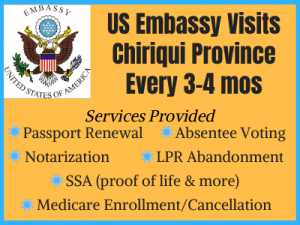
You can accomplish many tasks at one of these ACS travelling shows.
As I mentioned, the ACS visits David and/or Boquete every 3 to 4 months. If you are lucky, their visit will be in time to save you a trip to Panama City.
To find out when they will be in town, you can visit the embassy's website, email [email protected], or give them a call during their very limited phone-answering hours.
Unfortunately, the embassy doesn't set the date for ACS's visit to the Chiriqui province much in advance of it happening.
The ACS will only accept payment by local banker’s cashier check (known in Spanish as “Cheque Certificado”). That is, the check needs to be issued by a Panamanian bank. It must be made payable to “U.S. Embassy Panama” and have been issued within the past 5 months.
The ACS will NOT accept cash or credit card payments. The notarial fee is $50 per each signature of the Consular Officer.
Depending upon which ACS services you will be using, you will need to bring the following documents.
Passports: For adult passport renewals, in addition to the completed DS-82 application, provide one recent color photo with a white background that measures 5x5 cm (2X2 inches), your passport, and a photocopy of the photo page of your passport. The fee for an adult passport renewal is currently $110. If your previous passport was lost or stolen you will also need to bring a copy of the police report and the fee for the new passport is $135.
You will be happy to learn that you can complete adult passport renewals by mail (or Uno Express). You do not have to visit the embassy in person to renew.
For minor passport renewals, in addition to the completed DS-11 application, bring a copy of the photo page of the minor’s passport, a copy of both parents’ passports /cedulas, one recent color photo with a white background that measures 5x5 cm (2X2 inches) and a copy of the minor’s birth certificate, in addition to the original birth certificate and passport/ cedulas. The fee is currently $105.00 for a minor (under 16) passport renewal. The minor and both parents or guardians must appear in person. If only one parent is present in Panama, the “Statement of Consent from Absent Parent” Form DS-3053, notarized in the U.S., is required. Please note that the DS-3053 will not be accepted if notarized in Panama.
Notarizations: If you are requesting the notarization of your driver’s license, bring a photocopy of the front and back page of your license, as well as your license. If you are requesting notarization of benefits documents, bring the original and a copy of the document(s) showing the amount of benefits you receive monthly or annually. The notarial fee is $50.00 for each signature of the Consular Officer. Visit this US Embassy webpage to learn all the details regarding getting a document notarized there or at the visiting ACS unit.
Voting: You can submit your completed absentee ballot, no postage required, at the travelling ACS unit (or at the US Embassy in Panama City).
If you haven’t yet registered to vote or requested an absentee ballot, you can find out how to do those things by visiting the Federal Voting Assistance program's website. I also explain how US citizens can register and vote from Panama in this post: How To Vote in US Elections While In Panama.
LPR Abandonment: Bring completed form I-407 and a photocopy of your Permanent Resident Card, as well as your Permanent Resident Card. (Filling out this form means you decided to voluntarily abandon your status as a lawful permanent resident of the United States.)
The Embassy stresses that all your copies of the required documents, noted below, need to be legible.
SSA Proof of Life: If you are required to comply with this requirement, please bring your cedula or passport.
Medicare Enrollment/Cancellation: To enroll in Medicare, you should complete and sign form CMS 40B. To find out more about Medicare eligibility and how to cancel your participation, this US government Medicare page is a good place to start.
Social Security Replacement Card: Bring a copy of your valid U.S. passport and completed form SS-5FS.
Social Security Card for child under 12: Bring a copy of the U.S. passport for one of the parents, the child’s “copia integra” birth certificate, and the child’s U.S. passport (as well as copies) as well as completed form SS-5FS.
Change of Address for Social Security: Bring your current passport or cedula.
International Direct Deposit Enrollment: You should bring the necessary form and whatever other documents the form instructions requests. Before the ACS visit, e-mail the SSA Federal Benefits Unit ([email protected]) to request the enrollment form.
You can get more information on getting your Social Security checks directly deposited into your bank account (in the US or in Panama) on this US Embassy webpage.
If you live in Panama and have questions regarding Social Security, you must contact the SSA Federal Benefits Unit (FBU) located in Costa Rica. For more information on their services and how to contact them, please visit their webpage.
For comprehensive information on SSA’s services abroad, please visit SSA’s Service Around the World.
Also, I wrote a post about how to continue to receive SSA benefits while in Panama.
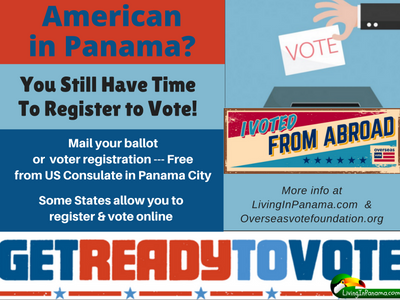
There are several websites that will help you both register to vote and vote. In many cases you can do these online. Some states allow voting by email or fax.
For resources on how to vote as an American overseas go here.
The US Consulate in Panama City has special postage paid envelopes available.
You can also create your own with a blank envelope and a printer. You can get the necessary information to print your own envelope from one of the online voter assistance websites for Americans living abroad. For instance, the Federal Overseas Assistance website has all the information you need for your envelope at this link.
Are you in the Chiriqui Province? The US Embassy is visiting David & Boquete on October 12th. You can hand in your absentee ballot during their visit. Don't have your absentee ballot yet? go here.
The US consulate is open only from 8 a.m. until noon. You don't need an appointment.
Take your envelope to Window 14 at the consulate.
The US Consulate is in the American Embassy complex in Clayton. You can visit the US Consulate in Panama's current voting information, by clicking here.
The US Consulate does not offer overnight mail. You should count on it taking 2 weeks for your ballot to reach its destination.
For the US Presidential election on Nov. 8th, the Consulate recommends that you get your ballot to them no later than Wednesday, October 26.
If it is less than 2 weeks from election day, you should overnight mail it using FedEx, DHL, or other service.
You also might want to contact your state election office to discover if you can fax or email it.
One or more of these sources for overseas voting should help you find out more about your options.
Please comment below
The video also includes Google Earth and Map images. This should give you a good context on the lot's location.
There is a link below the video if you want more information about the property. And, of course, we are always happy to answer your questions by phone or email.
[leadplayer_vid id="57E847F53D84A"]
..
Go here to browse all our Puerto Armuelles real estate
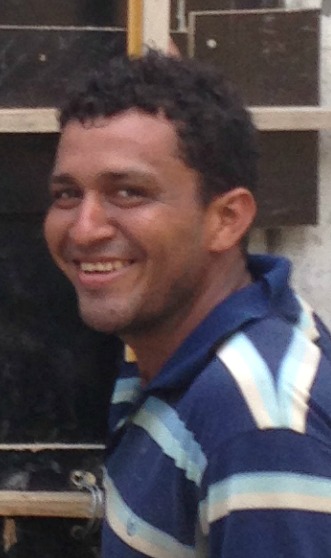
In fact, soon after our announcement our very first student began receiving one-on-one English conversation practice.
He appears to be advancing in his English speaking and listening proficiency at a very rapid rate. This student is highly motivated and also spends several hours each day listening to podcasts in English, as part of his self-created “English Immersion” program.
Obviously, we are still in the formulation phase of our project. We have no fixed structure in place. While we are still uncertain about the details, we are certain that there is a need for such a program. The best way to learn English is by being exposed to native English speakers.
If you are interested in participating in any way, please contact us.
Perhaps you have skills that could be useful to the program, even beyond simply tutoring in English. We are especially interested in talking with someone who is skillful in coordinating communication among the students and volunteers in the program. We are looking for volunteers to:
I am positive that I am not capable of all of the emails, texts, etc…that may be required, as the program gains momentum. However, I am available to participate in developing the process and introduce new tutors and students to the program. As the program grows, as I am sure it will, I may even be able to provide a physical space in Puerto Armuelles for holding classes, or one-on-one tutoring sessions.
Over the next year or so, it would be wonderful if we could offer English conversation opportunities to a 1 - 2 dozen motivated young people in Puerto Armuelles.
Hopefully, this program will help increase the English language proficiency in Puerto Armuelles. Fluency in English will certainly give these young people access to many opportunities in fast-developing Panama.
In recent months, we have talked with more expats who have plans to move to Panama, and Puerto Armuelles. Some of them already have a desire to help the young people of Puerto Armuelles. Many have also said they'd be interested in volunteering in the English tutoring program. Added to the longer-term expats in the area, we should be seeing a growing pool of potential volunteers.
Tutoring a young person from Puerto Armuelles in English is a great way to get involved in the community, in positive way, without making too big a commitment.
Not a Permanent Commitment
If you want want to volunteer, but don't want to commit, that is perfectly fine. You can assess as you go along. You can see if you would like to increase your participation, or back out if you discover you don't enjoy it. No worries or judgements. But for some expats, retiree or otherwise, this could be just the sort of adventure that they have been looking for.
An Exchange Program
We have also gotten requests for Spanish language lessons from local expats, particularly from retirees. For this reason, the idea of a “language exchange” program has emerged.
An exchange, or “intercambio” is a great way for an expat to share their own English language skills with a local youth. In exchange, the youth would help you to learn Spanish. This kind of program has been successful in many places. There is no reason that it couldn’t work for us here in Puerto Armuelles.
Please let us know if you are interested in participating in an intercambio.
Please let us know if you are interested or have any comments or suggestions.

“When I grow up,” Paul proclaimed, “I am going to build myself a house out of trash”.
(FYI - He never did build a house of trash. He teaches painting at Penn State)
I certainly wasn’t interested in living in a house made out of trash. It sounded kind of, well, trashy.
That was in 1979.
Fast forward 30 years, and nobody calls it “trash” any more.
Today we use the terms “recycled material” or “Post Consumer” material. We’re all building out of recycled materials, whether we realize it or not.
The fact is that many parts of our homes are made out of “trash” today. Thank goodness for recycling.
With 7 billion people living on the earth, and with the continued promotion of the “American Dream” (ie, a high consumption, high environmental cost, standard of living) there is going to be an ever greater need to get creative about using recyclables in home construction.
In Seattle, where our family is from, many creative remodelers and builders visit the Boeing Aviation Surplus Store to find such crazy building products as aluminum honeycomb fusilage, or solid aluminum bar stock “I-Beams”, and you name it. It’s pretty high tech stuff, but it appeals to a certain type of designer builder.
For instance, on an loft apartment/art studio project in which I participated, our crew used aluminum honeycomb panel fuselage material as the floor in a sleeping loft. Aside from being super cool to look at, since the hexagonal cells of the honeycomb were visible on the exterior sheet surface, the material was so rigid that it required no structural supports, other than the perimeter walls. Obviously this material calls for a different approach to building (ie, practically no framing support). This results in a very clean, ultra modern look. It wasn’t a look that I particularly liked for a human dwelling. It wasn’t traditional, cozy, or “homey”. Rather, it was “defiant”, “impervious”, “edgy”. It certainly challenged the viewer’s normal sense of what constitutes a home.
Of course, you can also find much more traditional recycled building materials in Seattle. There are many, many recycled building supply centers in Seattle, as there are in most metropolitan areas of North America. You can find old fir warehouse beams, recycled bowling ally floors, stained glass from old churches, antique bar mirrors and surrounds from 120 year old hotels.
When one comes to Panama, one doesn’t think about recycling. Most buildings are pretty new and made of cement.
However, Puerto Armuelles is unique here. What we have is a company town, former home of Chiquita Banana Company. “The Company” as it was known, imported most of the materials used to build the town of Puerto Armuelles, literally from the ground up.
If you have ever get the chance to explore inside an old Chiquita Banana house, up on stilts, you will surely discover lumber stamps from Portland, Oregon where this gorgeous, old-growth red cedar was milled well over half a century ago.
If you know anything about lumber, then you also know that the quality of the 2”x4”, 2”x6, 2”x8” framing material, as well as the 8”x8” and 8”x 10” support posts and beams is of such standard that has not been available as building material in North America for decades.
If one purchased it in the states today, the wood in the old Chiquita Banana Houses would be considered “furniture grade” and probably cost in the $15-$25 range per board foot—prohibitive for home building. I wouldn’t be surprised if our own house in Las Palmas contained over $50k worth of clear, old growth cedar.
If you look at the tightness of the growth rings, you will see that none of these trees could have been younger than 1000 years old. I love this beautiful old wood. Still, I’d much rather see the wood in the forest than in my house.
In addition to clear, old growth cedar, some of the more recent vintage Chiquita Banana Houses are built using the identical plan as the original Chiquita houses.
However, the newer models, dating from 25, 35, even forty years ago, are built from other exquisite woods. That is, these houses are built of dimensional lumber logged directly from the jungles (now, former jungles) of our own Punta Burica.
Just as the original Chiquita houses were built of ancient Cedar trees, so the newer generations of Chiquita houses are built of local, but equally ancient forest trees. Species such as Teak, Sangrio, Espave, Kirra, etc. A couple of these woods, particularly teak have very good resistance to termites. Sangrio and Kirra are gorgeous furniture quality hardwoods that are really too hard to be good framing material. They require pre-drilling, prior to sinking a nail.
As for the logic of cutting down a 10 foot diameter ancient rain forest tree in our local jungle just to make an 8”x8” structural post or beam in a Banana Company house, some of us have different views. I suppose back in the days of Chiquita Banana in Puerto Armuelles, nobody ever thought that the world would ever run out of wood. If you are from Canada, it might seem that there is still an endless supply of old growth trees.
I am not suggesting that one purchase Chiquita Banana houses and begin disassembling them and loading them into containers for export. But, rather, I am saying that there is a huge quantity of amazing building material available for those who are on a tight budget, but who have creative energy to burn.
Many of the original Chiquita Banana houses have fallen into disrepair. Since the local builders have a strong preference for building with concrete, many of these Chiquita houses just get scrapped, or used as concrete form boards.
A thorough search in the various neighborhoods of Puerto Armuelles would surely turn up some excellent salvage. I am guessing that one could purchase adequate salvage material from old Chiquita Banana houses to build an amazing beach house, for a couple to 5 thousand dollars.
This includes studs, joists, cedar siding, and super heavy duty galvanized roofing. There are still even a few old Chiquita hand washing sinks and toilets floating around in town.
I do not want to contradict what I said earlier about wood not being a desirable building material in our coastal/tropical climate. I stand by that opinion, if you are building a conventional house, using conventional methods and utilizing the labor force available in Puerto Armuelles at the present time.
Find out more, by reading why you shouldn't build with wood in Panama and why remodeling a wood home is not the best idea.
However, if you are artistic, high energy, and want to build something super inexpensive, something that is truly unique, and truly yours, building with Chiquita salvage could be ideal.
I think you might be able to come to Puerto Armuelles, buy a bargain priced lot for under $5k, and put up a completed structure, made primarily of recycled Chiquita Banana surplus.
The final product would be limited only by your own skill and imagination. This entire home could be built for well under $5k (total price for house and land under $10k).
Obviously, this sort of a challenge, and this kind of lifestyle, is not for everyone. However, if this sort of thing sounds like a fun adventure to you, you have come to the right place. Puerto Armuelles is a great place to experience this sort of an “alternative” eco- building lifestyle.
I have only mentioned Chiquita wood salvage so far, but Chiquita Banana imported other great materials as well. For instance, you will notice shortly after arriving in Puerto Armuelles, that many of the local fence posts are made from railroad rail, salvaged (stolen?) from the narrow gauge Chiquita Banana railroad tracks.
These tracks ran from the banana fields all the way to the shipping pier in downtown Puerto Armuelles. The train also ran to David. Some folks have reused this rail to build house posts, beams, storage buildings, hoists, racks, etc…
Imagine a practically unlimited supply of railroad rail. If this starts your mind thinking of possible projects, then you are the person I was hoping to communicate with in this article.
In addition to railroad rail, Chiquita imported miles of steel plumbing pipe, as well as some super thick walled steel tube section, both round and square.
Some of this material is still being sold just for its scrap iron weight. However, the salvage market is certainly getting more competitive, as materials prices go up. However, it depends on how good a scavenger you are.
If I could show some of this Chiquita Banana salvage to my friends from architecture school, they would probably have heart attacks. All this salvage, and very few people who have the design skill to take advantage of it.
If you have any questions about recycled Chiquita Banana building products, or about alternative building methods, in general, please contact us. We are always happy to share with you what we know, and we are eager to learn anything that you might be willing to share
[leadplayer_vid id="57C322E278CDC"]
Sometime I will remember to take a video when the thunder and lightening really gets going.
It can get very loud. And the lightening here flashes and spans the sky in ways I have not seen anywhere else.
Until late in August, it was not raining everyday. And when it rained it was typically raining for 1 to 2 hours in the afternoon.
But as we head into September, the rain is sometimes invading the morning hours.
Sometimes in November we can have days of rain.
If you are interested, I written more extensively about the rainy season and the overall climate in Panama.
For more on living in Panama, check out our blog and our frequently asked questions about Panama.
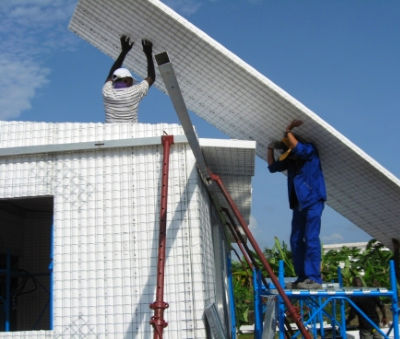
At the end of this article, I also briefly discuss remodeling a cement house.
I have spent my entire career building with wood: in Seattle, Alaska, even in Japan. So it seems strange for me to take such a strong stance against building with wood. Especially in Puerto Armuelles, which initially was built entirely with wood. The United Fruit Company, later Chiquita Banana, built Puerto Armuelles from the ground up using red cedar 2x4’s they shipped down from Portland Oregon.
I suppose if I were 36, or 46, rather than 56, I might feel differently. Or if I hadn’t already spent half of my life remodeling houses. Or if the weather were cool, as it is in Seattle, or Alaska.
I have met guys from various parts of the south, including Houston Texas who have told me that “Where I’m from it is 20 degrees hotter today”. These guys work in blue jeans in Panama. I have spent the better part of my adult life in the Pacific Northwest. On the hottest days in Panama, I sweat just standing still.
I guess what I am trying to convey is that it depends a great deal on the personality, and talents of the potential remodeler. If you are one of those men, or women, who has a tough time sitting still, or if you have looked forward to retirement so that you would have time for projects like remodeling an old Chiquita Banana house in Panama, then remodeling and old wooden house here might be just your cup of tea.
If you can pick up an historic, wooden Chiquita Banana house cheap and in good condition, it might be worth it. (Don’t forget to read the section on “termites” in my article on building with wood. Termites abound in coastal Panama, and they love to eat wood.)
Ten years ago wooden Chiquita homes in Las Palmas were going for $10,$20, $30,000. However, the current asking prices for the nicest homes in Las Palmas is in the $120k-$350k range. You can still pick up a deal, but the house is unlikely to be in good shape.
I would advise, as with any purchase in Puerto Armuelles, that you take your time, ask around. Eventually, you will find what you are looking for at a price that fits your budget.
In some of the less elite neighborhoods (that paradoxically are closer to the beach) deals are easier to come by. I think that, with patience, you still might be able to buy a wooden house in Carmen for under $14K, possibly even $11k. Carmen is a densely populated, working class neighborhood (noisy on the weekends). But Carmen is very well located on the ocean breakwater, at the south end of the downtown. The quality of the houses is already slowly improving in El Carmen, due to an inflow of new money into town. Many locals, even a couple of expats, are repairing and remodeling in Carmen. Prices can go nowhere but up.
Pressure treated 2x studs are available in David, imported from Canada and Chile, I believe. But they are expensive. At my last investigation, 2x6 pressure treated hem-fir cost over $2.00 per lineal foot. Prices may have come down, due to increasing demand; In the near future this may not be an unusual product anymore.
(Important note: I am not certain that I would want to live in a house made of such toxic wood, particularly if the framing lumber was left exposed. If that happens, the homeowner would end up in direct daily contact with the pesticide- impregnated wood.)
2. Labor cost. Another serious consideration when deciding whether or not to remodel a wooden house is labor cost.
On a per day basis, construction labor here in Puerto Armuelles is a steal. Workers get $20, $25, and $30 per day here. However, they don't have much experience working with wood. This means the efficiency level of these laborers is nowhere near a professional building crew in the States or in Canada.
A small 2 or 3 bedroom house that 2 skillful carpenters might frame in the States or Canada in a few weeks, could well take a crew of 6 men here several months to complete. And complete with a far lower quality of fit and finish. It is just not a woodworking culture.
There are those who would respond immediately “No Way. Don’t remodel a concrete block house. Far better just tear it down and start from scratch.”
I know from conversations with Milton Hutto, owner of Heavenly’s Hotel in San Vicente that he felt that he should have torn down the existing concrete house that became part of the West Wing of his hotel.
Most of his project was built using M-2, steel rebar, and concrete stucco. Obviously, Milton knows what he is talking about. He was there on-site during most of the construction, and he had prior building experience in Puerto Armuelles.
Watch a video of Milton talking about building a house in Panama, as an expat. Just click the link.
However, one should consider the scale of the project, before dismissing remodeling a concrete block house out of hand. In Milton’s case, he was building an 11 room hotel, not a small, single family, or single person dwelling. He employed a crew of at least 10 men. With this work force, costs were high, and quick progress was an absolute necessity.
Find out about building your house of concrete in Panama.
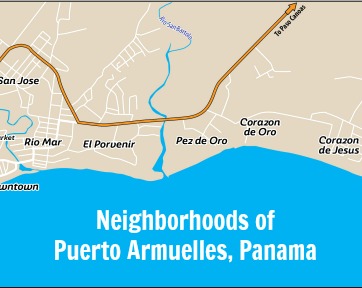
This map does not include all the neighborhoods in Puerto, but it show the ones of most interest to expats and retirees.
The map should help a visitor to more quickly get their bearings.
The 13 neighborhoods included on the map, going roughly from east to west:
Between downtown and Rio Mar is the Pueblo Nuevo neighborhood. It isn't shown on the map due to scale issues.
For information and photos of these neighborhood, click here.
The names of the rivers and creeks on the map are hard to read. So I am repeating them here.
Starting in the east, in the San Vicente neighborhood, and going west, the rivers are.
I will try to upload a higher resolution version of the map soon.
In the near future, I will have a map that includes the locations of restaurants, hotels, and other places of interest to people.
Want something shown on a Puerto Map?
Let us know.
If you want to know more about Puerto Armuelles, start here.